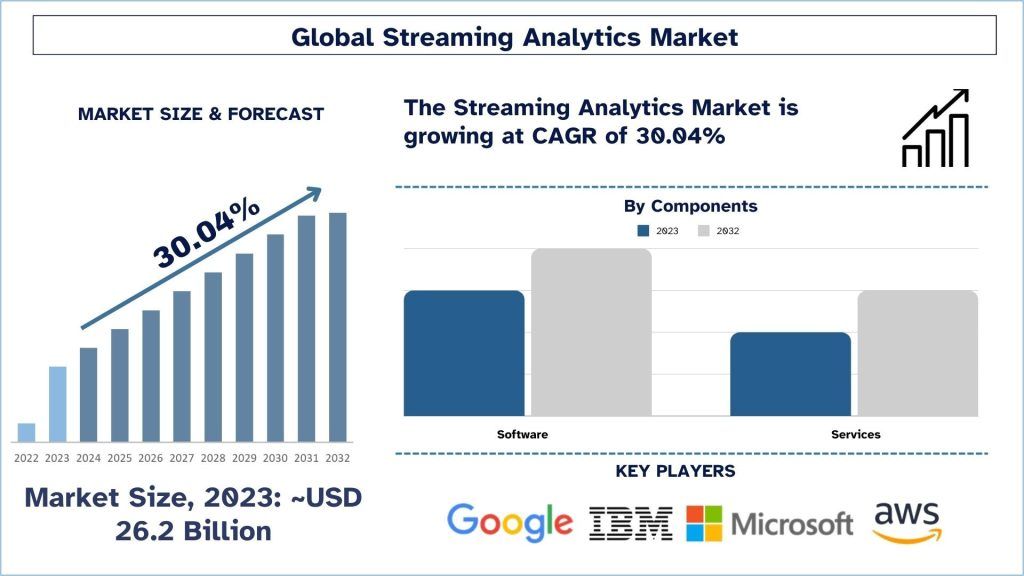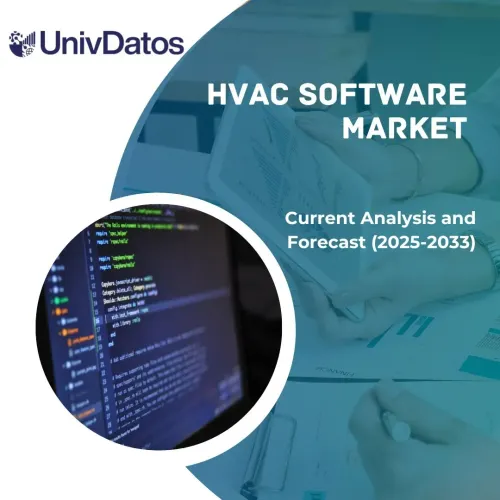ストリーミング分析市場:現状分析と予測(2024年~2032年)
コンポーネント(ソフトウェアおよびサービス)の重視;展開(オンプレミスおよびクラウド);アプリケーション(マーケティングおよびセールス、ネットワーク管理と最適化、ロケーションインテリジェンス、不正検出、その他);業界(ITおよび通信、メディアおよびエンターテインメント、BFSI、ヘルスケア、その他)および地域/国
世界のストリーミング分析市場規模と予測
世界のストリーミング分析市場は、2023年に262億米ドルと評価され、サイバーセキュリティに関する懸念の高まりに対応し、リアルタイムの脅威検出と対応を可能にするストリーミング分析のおかげで、予測期間(2024年~2032年)中に約30.04%の力強いCAGRで成長すると予想されています。
ストリーミング分析市場分析
グローバルなストリーミング分析市場は、ソーシャルメディア、IoTデバイス、トランザクションシステムからの継続的なデータフィードの分析のためのリアルタイムテクノロジーで使用されるテクノロジーおよびソフトウェアソリューションを意味します。この市場は、意思決定と業務をサポートするために、組織に高度な適時性で分析サービスを提供する能力によって特徴付けられます。グローバルなデータ統合および取り込み市場は、主にデータ生産の先例のない増加、IoTアプリケーションの急増、金融、ヘルスケア、小売セクターなどの分野全体での新たな分析の需要、意思決定におけるデータの利用への注力などの要因によって左右されます。また、クラウドコンピューティングと機械学習技術の進歩により、ストリーミング分析の適用性と能力が向上し、ストリーミング分析のビジネス実装率が高まります。
世界のストリーミング分析市場動向
このセクションでは、当社の調査専門家チームが特定した、世界のストリーミング分析市場のさまざまなセグメントに影響を与えている主要な市場動向について説明します。
マーケティングおよび販売セグメントが業界を変革
マーケティングおよび販売カテゴリは、ストリーミング分析市場をリードしています。これは、組織がリアルタイムのインサイトを使用して、顧客エンゲージメント、キャンペーンの計画と実行、および販売戦術を改善できるようにするためです。ストリーミング分析を通じて、ソーシャルメディア、eコマースプラットフォーム、デジタル広告など、さまざまなチャネルからの大量の顧客データを分析し、顧客の行動と傾向に関するリアルタイムのインサイトを得ることができます。これにより、マーケティングと販売は、コストとリスクを削減しながら、顧客価値を高め、コンバージョン率を最適化できるため、ほとんどの業界でストリーミング分析の成長が見られます。
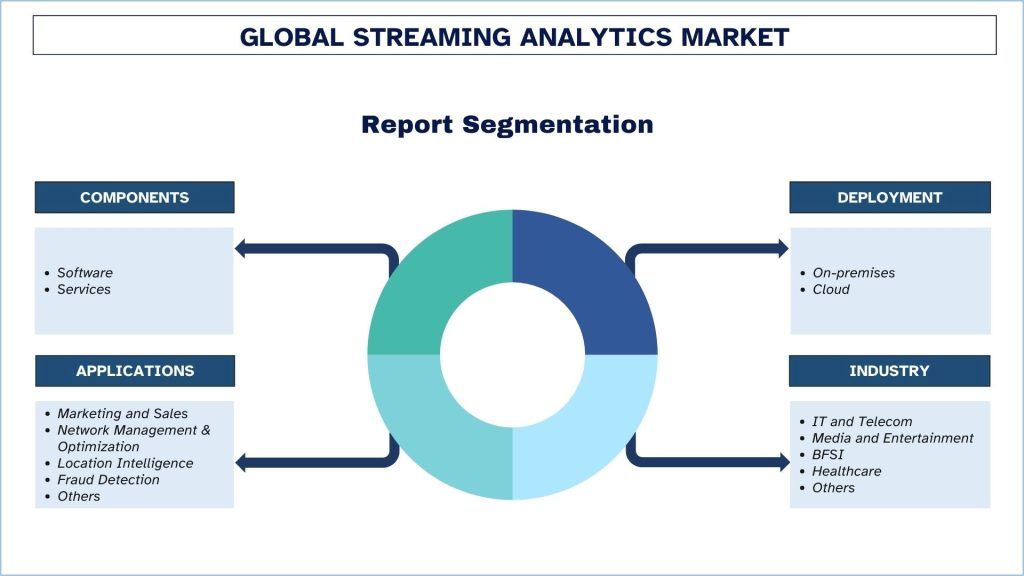
アジア太平洋地域も予測期間中に着実に成長しています。
アジア太平洋地域のストリーミング分析市場は、アジア太平洋地域のデジタル化、IoTの拡大、AIや機械学習などの技術の採用などのトレンドにより、急速に進化しています。今日、小売、金融、通信、製造業の企業は、ストリーミング分析をうまく利用して、リアルタイムでより良い意思決定を行い、活動を最適化し、顧客体験を向上させています。スマートシティ、5Gネットワーク、クラウドベースのソリューションへの移行により、需要が大幅に増加し、中国、インド、日本などの国が市場をリードしています。もう1つの推進力は、この地域の中小企業(SMEs)が、効率的で安価な統計分析およびビジネスインテリジェンスツールをますます採用していることです。
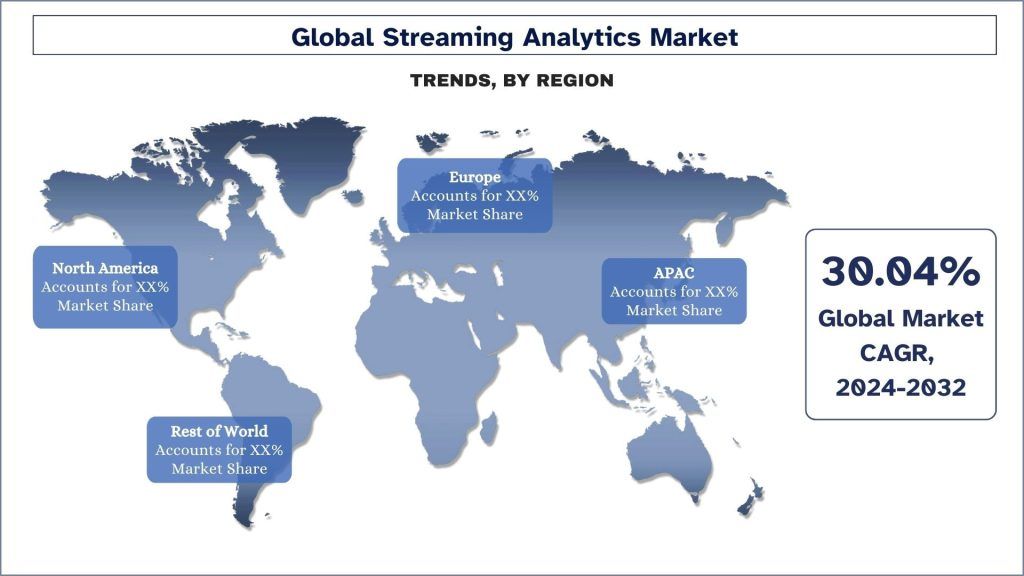
世界のストリーミング分析業界の概要
世界のストリーミング分析市場は競争が激しく、グローバルおよび国際的な市場プレーヤーが多数存在します。主要なプレーヤーは、パートナーシップ、契約、コラボレーション、新製品の発売、地理的な拡大、合併と買収など、市場でのプレゼンスを強化するためにさまざまな成長戦略を採用しています。市場の主要なプレーヤーには、IBM、Microsoft、Google Inc.、Software GmbH、Confluent, Inc.、Amazon Web Services, Inc.、Informatica Inc.、Impetus Technologies, Inc.、Cloud Software Group, Inc.、Oracleなどがあります。
世界のストリーミング分析市場レポートの範囲
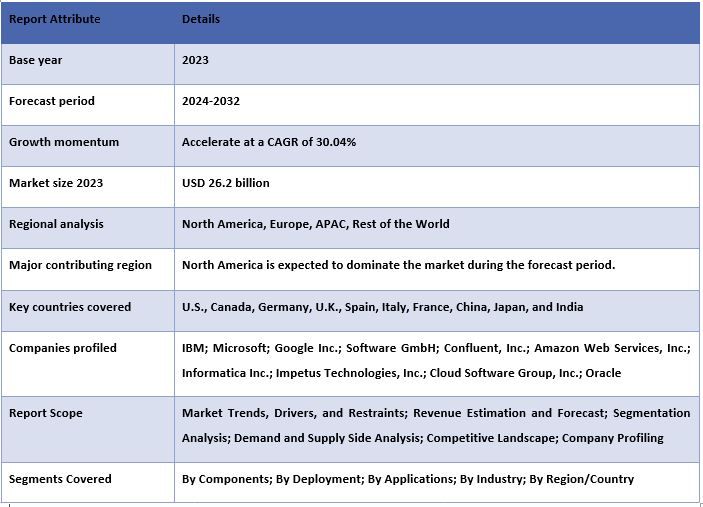
このレポートを購入する理由:
- この調査には、認証された主要な業界専門家によって確認された市場規模と予測分析が含まれています。
- このレポートでは、全体的な業界のパフォーマンスを一目で簡単に確認できます。
- このレポートでは、主要なビジネス財務、タイプポートフォリオ、拡大戦略、最近の開発に焦点を当てて、著名な業界ピアの詳細な分析を取り上げています。
- 業界で普及している推進要因、制約、主要なトレンド、機会の詳細な調査。
- この調査では、さまざまなセグメントにわたる市場を包括的に網羅しています。
- 業界の地域レベルの詳細な分析。
カスタマイズオプション:
世界のストリーミング分析市場は、要件またはその他の市場セグメントに応じて、さらにカスタマイズできます。これに加えて、UMIは、お客様が独自のビジネスニーズを持っている可能性があることを理解しているため、お客様の要件に完全に適合するレポートを入手するには、お気軽にお問い合わせください。
目次
グローバルストリーミング分析市場分析(2024年~2032年)の調査方法
グローバルストリーミング分析市場の過去の市場を分析し、現在の市場を推定し、将来の市場を予測することは、主要地域におけるグローバルストリーミング分析の採用を構築し分析するために行われた3つの主要なステップでした。過去の市場数値を収集し、現在の市場規模を推定するために、徹底的な二次調査が実施されました。次に、これらの洞察を確認するために、多数の調査結果と仮定が考慮されました。さらに、グローバルストリーミング分析市場のバリューチェーン全体にわたる業界の専門家との徹底的な一次インタビューが実施されました。一次インタビューを通じて市場数値を仮定および検証するために、完全な市場規模を予測するためにトップダウン/ボトムアップアプローチを採用しました。その後、市場の内訳とデータの三角測量方法を採用して、関連する業界のセグメントおよびサブセグメントの市場規模を推定および分析しました。詳細な方法は以下に説明します。
過去の市場規模の分析
ステップ1:二次情報源の詳細な調査:
年次報告書と財務諸表、業績発表、プレスリリースなどの企業内情報源、およびジャーナル、ニュースと記事、政府刊行物、競合他社の刊行物、セクターレポート、サードパーティデータベース、その他の信頼できる刊行物を含む外部情報源を通じて、グローバルストリーミング分析市場の過去の市場規模を入手するために、詳細な二次調査が実施されました。
ステップ2:市場セグメンテーション:
グローバルストリーミング分析市場の過去の市場規模を入手した後、主要地域におけるさまざまなセグメントおよびサブセグメントの過去の市場の洞察とシェアを収集するために、詳細な二次分析を実施しました。主要なセグメントには、コンポーネント、展開、アプリケーション、業界、地域など、レポートに含まれています。さらに、その地域でのテストモデルの全体的な採用を評価するために、国レベルの分析が実施されました。
ステップ3:要因分析:
さまざまなセグメントおよびサブセグメントの過去の市場規模を購入した後、グローバルストリーミング分析市場の現在の市場規模を推定するために、詳細な要因分析を実施しました。さらに、コンポーネント、展開、アプリケーション、業界、グローバルストリーミング分析市場地域などの従属変数と独立変数を使用して要因分析を実施しました。グローバルストリーミング分析市場におけるトップパートナーシップ、合併と買収、事業拡大、製品発売を考慮して、需要と供給側のシナリオを徹底的に分析しました。
現在の市場規模の推定と予測
現在の市場規模の算出:上記の3つのステップからの実行可能な洞察に基づいて、現在の市場規模、グローバルストリーミング分析市場の主要なプレーヤー、およびセグメントの市場シェアに到達しました。必要なパーセンテージシェアの分割と市場の内訳はすべて、上記の二次的なアプローチを使用して決定され、一次インタビューを通じて検証されました。
推定と予測:市場の推定と予測のために、ドライバーとトレンド、制約、および利害関係者が利用できる機会を含むいくつかの要因に重みが割り当てられました。これらの要因を分析した後、関連する予測手法、つまりトップダウン/ボトムアップアプローチを適用して、グローバル全体の主要市場全体でさまざまなセグメントおよびサブセグメントの2032年の市場予測に到達しました。市場規模を推定するために採用された調査方法は、次のとおりです。
- 収益(USD)の観点からの業界の市場規模、および国内の主要市場全体でのグローバルストリーミング分析市場の採用率
- 市場セグメントおよびサブセグメントのすべてのパーセンテージシェア、分割、および内訳
- 提供されるタイプに関して、グローバルストリーミング分析市場の主要なプレーヤー。また、これらのプレーヤーが急成長している市場で競争するために採用した成長戦略。
市場規模とシェアの検証
一次調査:主要な地域全体で、トップレベルのエグゼクティブ(CXO/VP、セールスヘッド、マーケティングヘッド、オペレーションヘッド、リージョナルヘッド、カントリーヘッドなど)を含むキーオピニオンリーダー(KOL)との詳細なインタビューが実施されました。次に、一次調査の結果が要約され、述べられた仮説を証明するために統計分析が実行されました。一次調査からの入力は二次的な調査結果と組み合わされ、それによって情報を実行可能な洞察に変えました。
さまざまな地域における一次参加者の分割
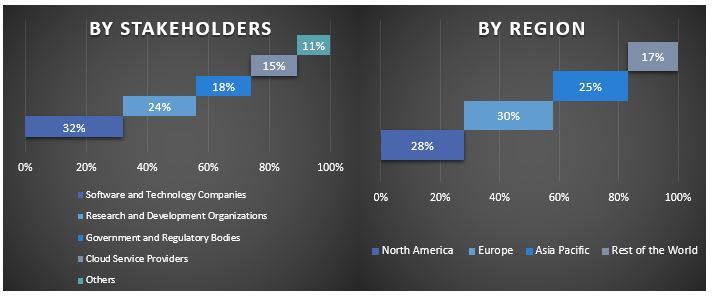
市場エンジニアリング
データ三角測量技術を採用して、全体的な市場推定を完了し、グローバルストリーミング分析市場の各セグメントおよびサブセグメントの正確な統計数値に到達しました。グローバルストリーミング分析市場のコンポーネント、展開、アプリケーション、および業界、および地域のさまざまなパラメーターと傾向を調査した後、データはいくつかのセグメントとサブセグメントに分割されました。
グローバルストリーミング分析市場調査の主な目的
グローバルストリーミング分析市場の現在および将来の市場トレンドが調査で指摘されました。投資家は、調査で実施された定性的および定量的な分析に基づいて、投資の裁量権を基盤とするための戦略的な洞察を得ることができます。現在および将来の市場トレンドは、地域レベルでの市場の全体的な魅力を決定し、産業参加者が未開発の市場を活用してファーストムーバーの優位性から利益を得るためのプラットフォームを提供しました。調査のその他の定量的な目標は次のとおりです。
- 価値(USD)の観点から、グローバルストリーミング分析市場の現在および予測市場規模を分析します。また、さまざまなセグメントおよびサブセグメントの現在および予測市場規模を分析します。
- 調査のセグメントには、コンポーネント、展開、アプリケーション、業界、地域の分野が含まれます。
- 業界の規制の枠組みを定義して分析します。
- さまざまな仲介業者の存在に伴うバリューチェーンを分析するとともに、業界の顧客と競合他社の行動を分析します。
- 主要な地域におけるグローバルストリーミング分析市場の現在および予測市場規模を分析します。
- レポートで調査された地域の主要な国には、アジア太平洋、ヨーロッパ、北米、および世界のその他の地域が含まれます。
- グローバルストリーミング分析市場の企業プロファイルと、プレーヤーが急成長している市場を維持するために採用する成長戦略。
- 業界の深掘り地域レベルの分析
よくある質問 よくある質問
Q1: グローバルストリーミング分析市場の現在の市場規模と成長の可能性は?
Q2:世界のストリーミング分析市場の成長を牽引する要因は何ですか?
Q3: コンポーネントカテゴリ別で、グローバルストリーミング分析市場シェアが最も大きいセグメントはどれですか?
Q4:世界のストリーミング分析市場における新たなテクノロジーとトレンドは何ですか?
Q5: グローバルストリーミング分析市場はどの地域が支配するでしょうか?
関連 レポート
この商品を購入したお客様はこれも購入しました

